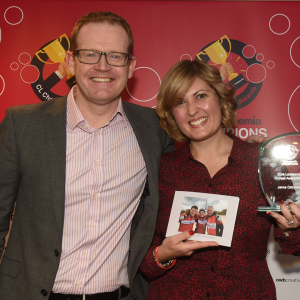
Lizzie Dean
'I would not be alive without Cure Leukaemia.' Read Lizzie Dean's Story
Acute Myeloid Leukaemia (AML) is a type of blood cancer, and affects the white blood cells, known as myeloid cells.
It’s an aggressive and fast developing form of leukaemia.
AML is a a blood cancer of the bone marrow’s myeloid cells, and it is the most common form of leukaemia in adults.
It is not 100% clear what causes AML, and there are no proven links to it being inherited or genetic.
However, there are a few factors that can increase someones chances of AML, including:
– Age, AML is more likely to develop in older people
– Blood disorders such as myelodysplasia, myelofibrosis or polycythaemia vera.
Symptoms of AML can include:
You should visit your GP if you are experience these symptoms.

'I am so lucky to say I am still in remission.'

'It's always someone else until it's you.' Read Jenna Ostrowski's story
Notifications